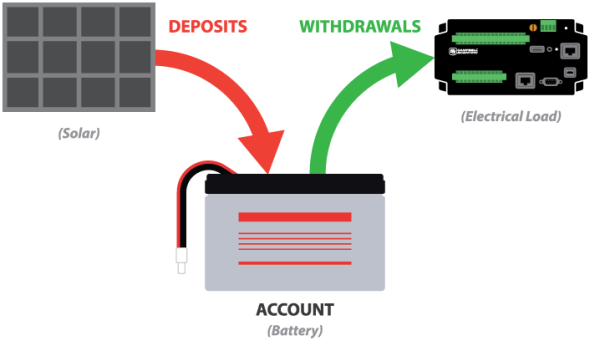How Much Power Does Your Data Acquisition System Need?
by Janet Albers | Updated: 05/04/2017 | Comments: 0

Are you wondering what size battery and solar panel you need to run all of the devices in your data acquisition system? How will you know if your power supply can keep pace with your needs? To get these answers, you will need to estimate the power requirements of your system. This is commonly referred to as a “power budget.”
When you think of your system’s power budget, it might be helpful to compare your power supply (battery) to a bank account. For example, a solar panel absorbs the sun’s rays as a source of energy and then recharges a battery. In this manner, the solar panel deposits funds into your bank account. Then, the devices in your system that use power from the battery make withdrawals from the bank account.
Note: Your battery needs to be large enough to accommodate continuous withdrawals—even during times when minimal deposits are being made, such as on cloudy days.
Estimating the power budget of your system can help you select the most suitable power supply option. You can approximate your system’s power consumption by calculating the average current required by the data logger, sensors, and peripheral equipment. This average current drain is primarily determined by the percentage of time the devices spend in an active versus quiescent state. You can approximate these states from the details specified in the data logger program.
For help estimating the power requirements of your system, we recommend using our "Power Budget Spreadsheet."
To help you use the spreadsheet, follow the instructions in our “Power Budgeting” video. The video covers making selections for the following parameters:
- Program intervals
- Minimum average temperature
- Desired backup and battery size
- Sun hours for the area
- Size of the solar panel
|
Recommended for You: For more information, and guidance through the calculations needed to estimate your power budget, review our "Power Supply Overview" brochure and "Power Supplies" application note. |
I hope the tool mentioned in this article helps you determine and meet the power needs of your data acquisition system. With a continuous, sufficient power supply, you can help ensure you are collecting the measurement data you need.
If you have any questions or comments, post them below.




 Janet Albers, now retired, was a Senior Technical Writer. She enjoyed sharing tips, simplifying concepts, and guiding our clients to a successful project. She had been with Campbell Scientific, Inc. longer than the CR1000, but not quite as long as the CR10X. After work hours, Janet enjoyed the outdoors with her boys and dogs.
Janet Albers, now retired, was a Senior Technical Writer. She enjoyed sharing tips, simplifying concepts, and guiding our clients to a successful project. She had been with Campbell Scientific, Inc. longer than the CR1000, but not quite as long as the CR10X. After work hours, Janet enjoyed the outdoors with her boys and dogs.
Comments
Please log in or register to comment.